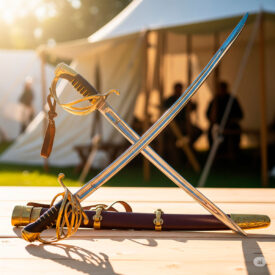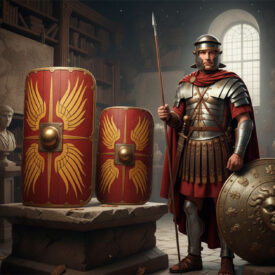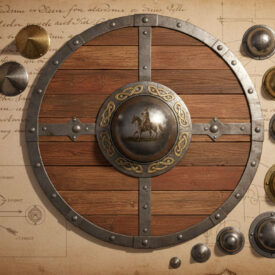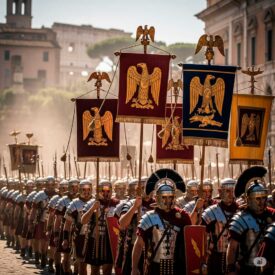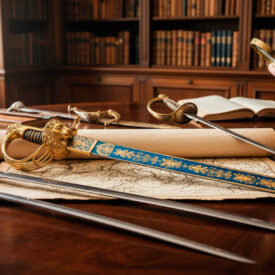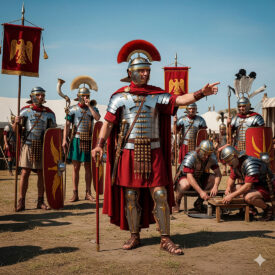Imagine a Roman battlefield, the roar of the legions, the clash of swords… and suddenly, a sharp, piercing sound rising above the chaos, guiding the cavalry to victory. What instrument would be capable of producing such a clamor? It was the lituus, an enigmatic instrument that has puzzled historians and musicians for centuries. What did the lituus really sound like and what role did it play in the Roman war machine? Embark with us on a journey through time to uncover the secrets of this fascinating military and ritual instrument.

Origins and Dual Nature of the Lituus
The term lituus is a concept rich in meaning, with a dual identity that encompasses both the sacred and the martial. Its Etruscan origin, meaning “twisted” or “curved,” lends its name both to a ritual staff carried by augural priests and to a brass instrument whose curved design was unmistakable.
Tradition has it that it was a priestly trumpet used by Romulus himself when proclaiming the founding of Rome, which gave a divine aura of legitimacy to its military use.
The Chronology of the Lituus: A Journey Through Time
| Era | Event |
|---|---|
| I. Etruscan Origins and Archaic Roman Period | |
| 7th Century BC or earlier | Etruscan brass instrument with a high pitch, precursor to the Roman lituus; the Etruscan cornu, from the same family, can be dated to this century. |
| Founding of Rome | Tradition records that the lituus was the priestly trumpet employed by Romulus when proclaiming the name of the city. |
| Until 390 BC | The lituus (as an augural staff associated with the tradition of Romulus) remained in use until after the Gallic invasion (390 BC). |
| Early Imperial Period (before Tacitus) | The lituus appears as one of the three types of Etruscan metal trumpets alongside the tuba and the cornu. |
| II. Usage in Ancient Rome (Republic and Empire) | |
| 500 BC | Related instruments, such as the tuba (straight trumpet), began to be manufactured in Rome. |
| Before 100 AD | The lituus was mainly made of bronze. |
| Imperial Era | In addition to bronze, the lituus also began to be constructed from animal horn decorated with silver; its use encompassed civil, religious, and military contexts. |
| Imperial Period | Music accompanied public spectacles (e.g., in the circus) and typical instruments included the tuba, the lituus, and the organum. |
| 2nd Century AD | Finds at the Saalburg castra (Germany) allow replicas of the lituus to be associated with this century; its use in military and civil spheres is documented. |
| III. Decline, Confusion, and Partial Survival (post-classical) | |
| Post-Fall of the Empire | Precise knowledge of the acoustic lituus is lost and its construction tradition disappears. |
| Early 15th Century | Jean de Gerson erroneously classifies the lituus as a stringed percussion instrument, showing semantic dissociation from its real nature. |
| 17th Century | In Germany, a variant of the ancient lituus used as a signaling horn by watchmen persists. |
| 1722 | Colin Maclaurin names the polar spiral θ·r² = a as «lituus» in mathematics, due to its visual resemblance to the Roman augural crook and the episcopal crosier. |
| Mid-18th Century | J. S. Bach specifies the lituus in some works (e.g., cantata BW 118); Kürzinger (1763) describes the medieval lituus as an early variant of a natural trumpet or horn. |
| 18th Century | Anton Joseph Hampel is described as «royal lituus player», evidencing the use and denomination in specialized musical fields. |
| Late 19th Century | The shape of the augural lituus is maintained in iconography and is adopted as the model for the episcopal crosier, symbolizing pastoral authority. |
| IV. Modern Reconstruction | |
| May 2009 | Scientists at the University of Edinburgh attempt to recreate the lituus, as the instrument had not been used for almost 300 years. |
| Present Day | Modern researchers have undertaken reconstructions of the lituus specified by J. S. Bach, as the original construction tradition was lost. |
| Summary of Morphological Evolution | |
| Description | The original Roman lituus was a brass instrument (bronze) with a long cylindrical tube (approx. 75 cm–1.40 m) and a J-shaped or hooked end. In the 17th century, it survived as a signaling horn; in the Baroque period, Bach specified a reconstructed instrument as a long straight wooden trumpet (≈2.5 m) with a flared bell, different from the Roman design. |
A Powerful and Strident Sound: The Acoustic Profile of the Lituus
Classical texts leave no room for doubt: the sound of the lituus was unmistakable. It was described as “powerful,” “strong,” “harsh,” and, above all, “sharp” and “strident.” Terms like stridor lituum (stridency of the litui) and sonitus acutos (sharp sound) give us a clear idea of its acoustic character. This sound profile was not accidental, but a vital necessity in the heat of battle.
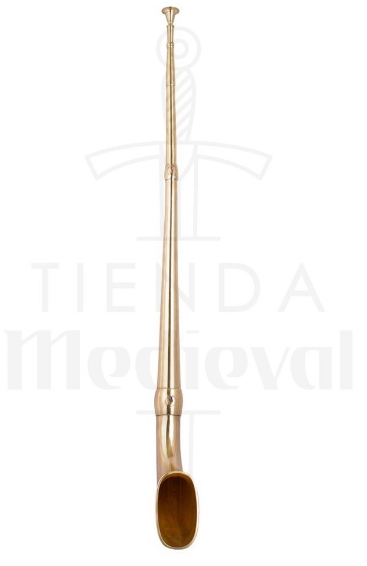
A sharp and penetrating sound was essential to “cut through” the ambient noise of a battlefield, allowing orders to reach the furthest limits of the troops, even kilometers away. The liticines, as the musicians who played it were known, mastered a technique similar to modern trumpeters, using lip vibration and breath control to modulate the sound. Thus, the lituus could produce both deep, resonant tones and those characteristic sharp, penetrating ones.
The Lituus on the Battlefield: Specialization and Symbolism
Although its name evoked the augural staff, the lituus was an instrument of war. Used as a signal trumpet, its primary function was vital for the Roman army. Its penetrating sound made it the perfect choice for the cavalry, a military unit in constant motion that needed to transmit quick and clear orders to its dispersed ranks.
The musicians who played the lituus, generally members of the cavalry, enjoyed a privileged status, even becoming “junior officers” (principales). Their ability to control and coordinate thousands of soldiers through coded sound messages was an invaluable tactical advantage. From “March forward” to “Deploy,” the life of the legionary was intrinsically linked to the calls of the lituus.
But the lituus was not only a military instrument. Its curved shape, reminiscent of the augural staff, implied that the orders transmitted by its sound were divinely legitimized. This symbol of authority extended to civil and religious contexts, accompanying processions, spectacles in the circus, and even funerary rituals, where its image is frequent on Roman sarcophagi.
Resolve your doubts about the lituus and Roman military music
How was the lituus used in Roman battles?
The lituus in Roman battles had primarily ceremonial and military signaling functions, although its use in direct combat was limited.
Main Function
The lituus was an instrument of exclusively military use employed in the cavalry. Its primary function was to transmit orders to soldiers during combat operations. The powerful sound of the lituus could be heard several kilometers away, allowing instructions to be communicated through coded sound messages that indicated to the legionaries exactly what orders they should carry out.
Specific Signals
Battle signals transmitted by the lituus and other instruments included orders such as “March forward,” “Turn left,” “Conversion to the right,” “Deploy,” “Reform,” and other essential tactical maneuvers to coordinate troop movement.
Control of Military Life
The daily life of legionaries was completely governed by the calls of the lituus. Soldiers would wake up, go to sleep, and perform guard changes according to the signals of this instrument. This provided the Romans with an incredible tactical advantage, as it allowed for the complete control of an army of up to 6,000 soldiers in coordinated and efficient combat.
The musicians who played the lituus generally belonged to the cavalry and were ranked in the military hierarchy among the “junior officers” (principales).
What were the differences between the lituus and the Roman tuba?
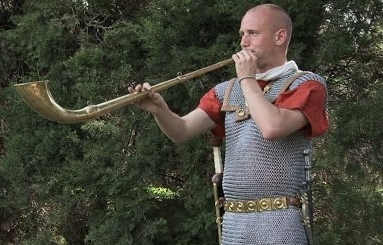 The differences between the lituus and the Roman tuba are mainly the following:
The differences between the lituus and the Roman tuba are mainly the following:
- Shape and structure: The Roman tuba was a straight, cylindrical tube, approximately 1.2 to 1.5 meters long, with a flared bell-shaped end; in contrast, the lituus had the opposite end to the mouthpiece bent in a J-shape, with a curved bell, similar in appearance to a smoking pipe or the Celtic carnyx horn.
- Military use: The tuba was preferably used in the infantry for signals and orders to charge or retreat, while the lituus was an exclusive instrument of the Roman cavalry.
- Timbre and sound: The tuba had a “hoarse” and “terrifying” sound, deeper and more vibrant, while the lituus produced a sharper, more strident, and penetrating sound.
- Origin and function: Both instruments have Etruscan roots, but the lituus was also used in rituals, processions, and funerals, with a ceremonial use in addition to military.
In summary, the tuba was a straight trumpet for military signals in the infantry with a deeper sound, while the lituus was a curved trumpet, with a sharper and more strident sound, used in the cavalry and in ceremonies.
What other military instruments did the Romans use?
The Romans used various military instruments to communicate and give orders on the battlefield and in the camp. The main ones were the cornu, the tuba, and the buccina. The cornu was a curved, large, and reinforced instrument, used for signals such as starting the march or pitching/dismantling camp. The tuba was a straight trumpet, primarily used in combat to order actions such as redoubling the fight. The buccina was similar to the tuba but with a more curved shape, and also served to transmit orders. Additionally, there were other instruments such as the lituus, J-shaped, and the aulos, although these were less common and more ceremonial. Whistles and drums were also used for specific signals and orders.
How was the lituus manufactured in ancient Rome?
 The lituus was manufactured by leveraging Roman skills in metal turning. This instrument was a long cylindrical bronze trumpet that had variable dimensions, generally between 75 cm and 1.40 m in length.
The lituus was manufactured by leveraging Roman skills in metal turning. This instrument was a long cylindrical bronze trumpet that had variable dimensions, generally between 75 cm and 1.40 m in length.
The manufacturing process involved working the bronze to give it a cylindrical tube shape, with the end opposite the mouthpiece bent in a J-shape. This curved end terminated in an open bell that sometimes had trimmed edges, which allowed it to provide that characteristic sharp and strident sound of the instrument.
The Romans mastered sophisticated metallurgical techniques that allowed them to create not only the lituus, but also many variants of trumpets: straight, curved, and wide-mouthed with elaborate designs. This mastery in the art of metal turning is what distinguished the Romans in the manufacture of wind instruments, allowing them to produce instruments of superior quality compared to other civilizations of the time.
What role did military music play in the daily life of legionaries?
Military music was fundamental in the daily lives of legionaries, as it served both to organize daily activities and to coordinate maneuvers in battle. Musicians, such as tubicines and cornicines, had a privileged status and were responsible for transmitting orders through specific musical signals, such as the call to wake up, march, or attack. In addition, music accompanied movements, parades, and rest periods, strengthening the discipline and morale of the army.
Thus, the lituus stood as a sonic beacon of the Pax Deorum and the imperium, an authoritative, loud, and strident voice, capable of cutting through the din of battle, ensuring that the divinely sanctioned orders of the cavalry reached all its riders. Although its tradition was lost over time, the lituus endures as a fascinating testament to the military and cultural sophistication of ancient Rome.
